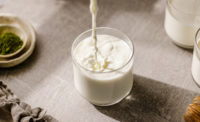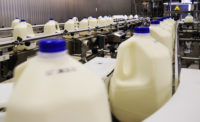Does your milk taste bad? Part 2
Preventing spoilage organisms in raw milk by following dairy industry standards.

Photo courtesy of courtneyk via gettyimages.com

In our last Dairy Foods’ column in June, we examined the spoilage organisms found in pasteurized milk. If you recall, I talked about ruining my breakfast cereal with off-flavored or spoiled milk. In this article, we are going to look at some of the issues that affect the quality of milk before pasteurization.
Whether you are pasteurizing with HTST, HHST, or UP type equipment, one fact remains: milk will never improve in quality after it leaves the cow, but it can deteriorate during each step of its journey to that breakfast cereal.
I learned early on in my career that the three keys to producing high-quality dairy products are:
- Keep it Clean.
- Keep it Cold.
- Keep it “Moo-ving.”
Two of those keys are self-explanatory. Cold means keep the milk as cold as possible. While the Project Management Office (PMO) says below 45 degrees Fahrenheit, the goal for high-quality dairy products should be 40 degrees Fahrenheit or lower. Moving simply means to process and distribute dairy milks as quickly as possible to preserve freshness.
So, let’s concentrate on keeping it Clean. While a robust sanitation program within the plant is certainly a big part of keeping it clean, what we really mean here is keeping the product free from both pathogenic and spoilage organisms. That includes both the raw and pasteurized sides of one’s dairy pasteurization process. While some might suggest that the raw side is less important because the milk is going to be pasteurized, that is wishful thinking as there are many issues on the raw side of the operation that can affect quality.
First, let’s look at the types of microorganisms that can survive pasteurization.
Commonly called psychrotrophic spore formers, psychrotrophic strains of spore-forming bacillus, paenibacillus and related organisms can be common contaminants in the farm environment since they’re often associated with soil, feed or manure. These gram-positive, spore-forming rods can easily be introduced to the milk itself through milking practices.
The spores are more able to survive heat and sanitizers. In fact, the heat of pasteurization serves to activate the spores, so they grow as vegetative bacteria. Studies have shown that increasing pasteurization temperatures may result in more rapid growth with off-flavors showing up 10 or more days after pasteurization at refrigerated temperatures.
And while the farm can be a primary source of psychrotrophic spore-formers, raw milk transport, storage and handling should not be overlooked. Poorly cleaned milk processing equipment, both on the raw side and the pasteurized side of the facility can be sources of these organisms.
Raw milk can also contain psychrotrophic bacteria that are easily killed by pasteurization. Yet, sometimes bacteria may produce heat-stab;e enzymes that can survive pasteurization and remain active in finished dairy foods and beverages. Consequently, these heat-stable enzymes may lead to off-flavors and reduced shelf life. Thus, spoilage caused by psychrotrophic bacteria in raw milk and the heat-stable enzymes produced can be of major concern.
Historically, these enzymes have been known to survive HTST and ultra-high temperature (UHT) processing, thereby producing defects. For example, proteolytic enzymes that can survive UHT processing can cause gelation and the development of bitterness in the finished product.
It is imperative that a facility have programs in place to control the possibility of contamination. This program starts with receiving the milk. In addition to the standard practices of a sensory examination of the milk, antibiotic testing, butterfat testing, checking the titratable acidity, and checking the temperature of the load prior to receiving, it is suggested that a Direct Microscopic Clump Count (DMCC) be conducted on each load of raw milk prior to its receipt. Milk should have a DMCC of 50.000 clumps per ml. or less.
In addition, control can be exercised through good industry standards including steps to prevent or eliminate potential bacterial growth within the facility itself. These controls include a vigorous sanitation program for the raw side of the operation itself as well as a preventive maintenance program to eliminate all leaks or drips. This positively reduces the potential for introducing harmful spoilage bacteria from raw milk into the plant environment.
Remember, spoilage might start at the farm, but it ends in the package.
Tedd Wittenbrink is the technical director for Merieux NutriSciences.
Looking for a reprint of this article?
From high-res PDFs to custom plaques, order your copy today!





